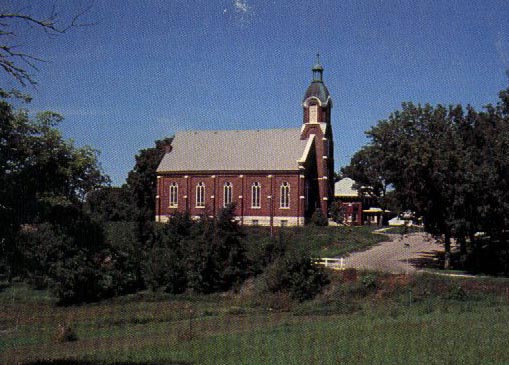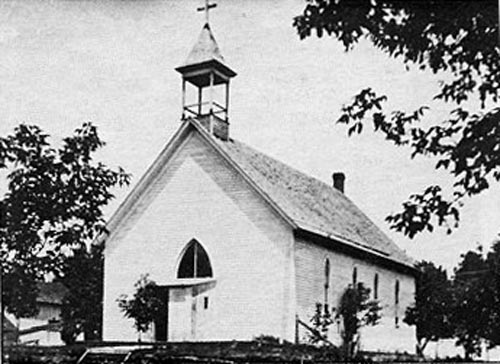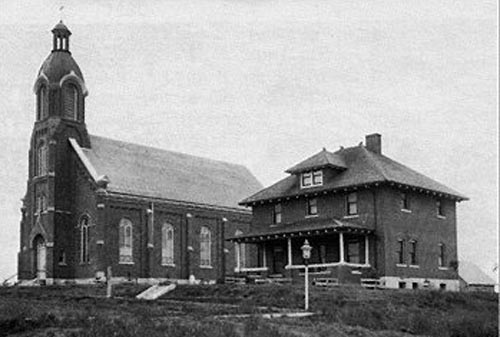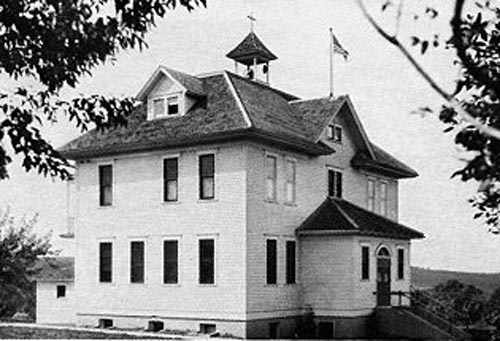St. Boniface Catholic Church
Charter Oak, Iowa
1883-1983

"Great Things Happen When God Mixes With Man"
Also included in the book are the names of those baptized in the church from 1896 to 1921 and marriages from 1909 to 1931, as well as a number of historical photos.
The history of St. Boniface Parish dates back to 1883 when 4 or 5 families purchased a 40 acre site 4 miles northeast of Charter Oak, Iowa. Msgr. B. Lenihan, pastor of St. Rose of Lima in Denison persuaded these people to buy a few lots in Charter Oak for their church. They held services in a school house southeast of Charter Oak until the church was finished. It was erected 2 blocks east of the First National Bank.

Rev. M. J. Farrelty had been recently installed as Pastor of St. Rose of Lima and also the care of St. Boniface.
In Oct. 1896 the first resident pastor Rev. M. Costello came to Charter Oak to organize the Parish. After 2 years he was succeeded by Rev. L.J. Cooper who purchased and equipped a rectory. He also had the Church moved to a more convenient location a block south. Some of the early organizers of the parish were Patrick Copps, A. Jobken, John Kreamer, Emil Ohnimus, Peter Sasges, John Simmons, Otto Staley, Anthony Topf, and John Ullerich.
In June, 1908, lightning struck the Church and burned it to the ground. Fr. Ecker was pastor at this time. A new pastor, Rev. L. Schenkelberg was appointed and when he arrived there was no church. With the help of the Parishioners they selected a new site for the Parish Buildings in the southwest part of town. An architect was chosen and the present church, a building 80 x 44 of Romanesque style was selected. In April 1909, the contract was let for a brick building.
On Sunday, Oct. 31, 1909 Mass was offered for the first time in the new church. The congregation had waited 15 months for the chance to worship in their own church. The main alter was donated by Rev. L. Schenkelberg and the Blessed Virgin Alter by Mrs. G. Schleis, Sr. and Mrs. J. Brummer. While waiting for the completion of the church, mass was offered in the City Hall, and confessions and religion instructions were scheduled in the rectory. By 1910, the new brick rectory was built north of the church.
- Pastors of the last 100 years
- Father Schenkelberg
1908 to Nov. 26, 1913 - Father Schaefer
1913 to 1916 - Father Louis Anthofer
Nov. 26, 1916 to Nov. 3, 1927 - Father Joseph A. Roder
Nov. 3, 1927 to June 12, 1929 - Father Aloysius Arndorfer
June 12, 1929 to July 1, 1937 - Father Leo Schumacher
July 1, 1937 to July 3, 1940 - Father Cletus Ahmann
July 3, 1940 to June 2, 1944 - Father George O'Brine
June 2, 1944 to October, 1946 - Father Charles Kniep
October, 1946 to April 2, 1949 - Father Reinhard Nemmers
April 2, 1949 to June 6, 1967 - Father Robert Thiele
June 7, 1967 to Feb. 14, 1973 - Father Joseph Lisowski
Feb. 14, 1973 to July 30, 1974 - Father Eugene Walding
July 30, 1974 to present
The St. Boniface School was built in 1914 under pastorage of Rev. A.G. Schafer. An eight grade course of study and religion was offered, two large classrooms, two music rooms and a chapel were on first floor, two dormitories, that accommodated 30 to 35 boys and girls, and the Sisters living quarters were on second floor. A large attic was used for storage. The kitchen, dining room, utility room, furnace and storage rooms were in the basement with two exits near ground level. Many children from St. Mary's at Ute and surrounding country side of St. Boniface boarded during the week.
The school was staffed by the Benedictine Order of Sisters from Wichita, Kansas, under Mother Superior, Sr. Mary Appolonia, until the fall of 1923 when the Sisters of St. Francis of the Holy Family of Dubuque, Iowa, under Mother Superior, Sr. Mary Marcellina. Religion was taught by the pastor. Music lessons were always in demand and were available to anyone interested. Piano and violin were most popular. Recitals were presented to the public. School programs and graduation exercises were held in the Theater and Opera House. Large First Communion dinners were served at the school using classrooms for dining rooms before "24".
By the spring of 1924, the rest of the church basement had been remodeled and finished off for an auditorium and dining room combined. The part on the west side that served as a room for mass when the weather was cold and stormy was made into a kitchen. This room had also served as a gathering place for small socials and meetings before 1924. The chapel was also used during the week and on Sunday during extreme cold weather to conserve on fuel.
The school closed in 1951 due to small enrollment. Sisters from St. Mary's at Mapleton came on Saturdays to hold catechism classes, until in 1960, C.C.D. classes were conducted each Saturday under the supervision of Rev. R. E. Nemmers and lay teachers. Around 60 pupils were enrolled in the classes at this time. The first lay teachers were: Elaine Staley, 1st grade, Marian Remmes, 2nd grade, Evelyn Struck, 3rd and 4th, Clara Brummer 5th, 6th and 7th, and Rev. Nemmers taught 8th. Sophia Sailer and Rev. Nemmers had the high school students. Many volunteers have helped through the years. Clara Brummer completed 18 years and Sophia Sailer is on her 23rd year at this writing.
The old wooden doors were removed from the church entrance and replaced with glass doors which were donated in memory of Joseph Kofmehl. The Ecumenical Council approved a change whereby the Priest would face the people while celebrating mass and soon English was said instead of Latin. Missalettes were introduced which made it simpler to follow the Holy Sacrifice of the mass. Congregational singing was another change that came in time.
In the spring of 1968, Father R. A. Thiele, who had succeeded Rev. R. Nemmers in June of 1967, started the remodeling of the church basement with the help of his parishioners. The stage was removed, floor finished cementing out, walls paneled, new ceiling, lights, wiring, carpet on stairs going up into church, new ladies restroom was put in and the men's room was remodeled. Book closets and folding doors to divide the classrooms were installed. The floor was finished with torginof. In the kitchen new cupboards were added, walls were paneled and painting was done. The hall has held programs, socials, bingo games and parish dinners besides being a Catechectical center. In May of 1968 the fence was removed from the west side of the cemetery which made It easier to mow and trim and for appearance sake.
In 1969 the school was taken down. Some of the lumber was sold and then a double garage near the back entrance of the rectory was built with part of the lumber. The inside of the garage was lined with the wainscoating from the classrooms and hallway. The attic was insulated and new siding was purchased. Many volunteers again helped with the cement work for walks, driveway, footings and floor. This added an asset to the grounds.
Dec. 1971, Mr. and Mrs. Pat Delanty donated the Nativity Scene used in our Christmas Crib. Holy Water Fonts donated by Mr. and Mrs. John Topf and Mr. and Mrs. C. Topf and family replaced the self standing white marble fonts - one of which was donated by Mr. and Mrs. Chas. Quandt in the early 30s. The Holy Water Fountain was donated by Mrs. John Throckmorton and Tom in memory of John Throckmorton.
Feb. 1972, the church interior was redecorated after 20 years. In the spring the pews were taken up and the entire floor was carpeted. The Ladies Society donated $1100 and the children donated $451 from their fund. This also put carpet on the stairs to the balcony. Fr. Thiele said he'd donate the carpet for his sacristy "as he used it". The strips left over were laid in the servers sacristy.
Feb. 14, 1973, Fr. A. Thiele who came here in 1967 was sent to Danbury. Rev. J. Lisowski succeeded him and in July 1974. Rev. E. Walding arrived.
In 1978, amber colored glass was installed on inside of windows to conserve heat. The following families donated these windows. Kent Barnett, Leo Bechen, La Verne Brummer, Gerrold Gangestad, Don Murray, Leroy Matthews, Harrison Peters, Chas. Quandt, Ohnimus family, Albin Rickert, Bernard Remmes, Frank Staley, Leonard Staley, Leo Staley, Otto Staley, Wm. Staley, Strucks and Keating, Martin Sailer, John and Leona Topf, Clarence Topf, Ray Williams, and Leo McWeeny.
In Sept. 1978, the organ was traded in on a used 4 year old Conn Organ for additional $1500. 1978, the interior of the church was painted and decorated as a result of rain damage that occurred while the roof was being shingled. The carpet in a shade of rust and brown was laid in the sanctuary at this time. The gold carpet was removed and laid in the balcony. New chairs and kneelers completed the sanctuary.
Aug. 1979 the parking lot south of the church was graded up and hard surfaced. Twenty or more cars can be parked. Oct. 1980, three new gas furnaces were installed in the St. Boniface Church basement to heat the church and hall. Insulation had been put in the church attic to conserve heat. Pine trees were set along the south side of the parking lot.
Submitted by Bob Kuehl
To Baptisms
To Marriages


